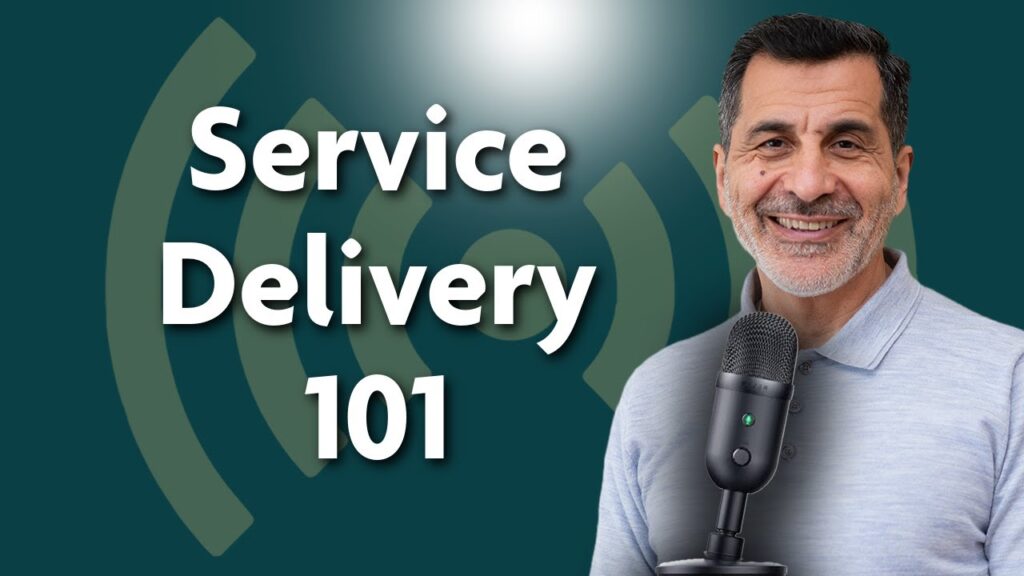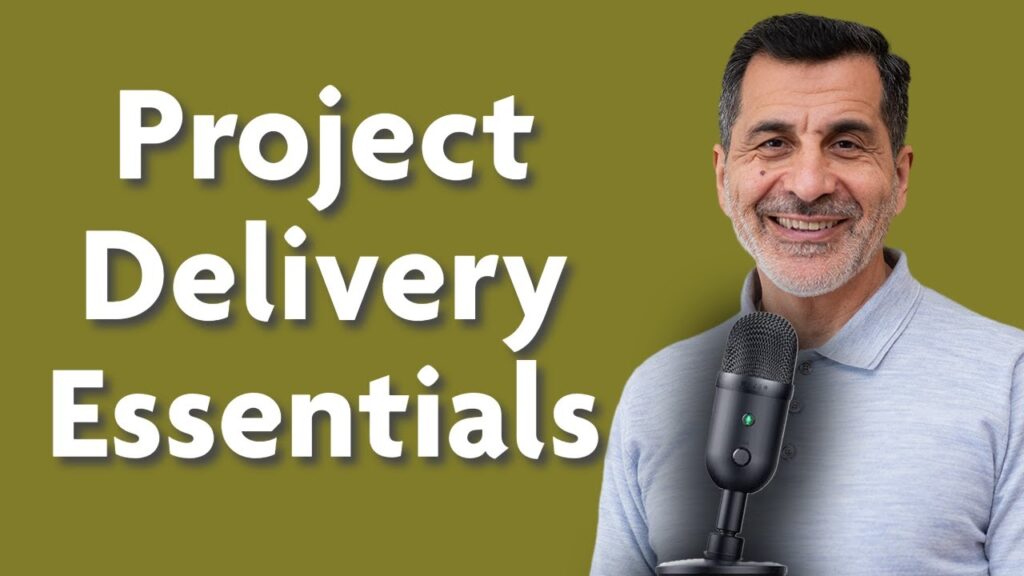Master The Service Delivery Model And Transform Your Client Experience
I've built seven thriving businesses from the ground up, generating over $65 million in revenue, mostly by mastering one crucial skill: exceptional client delivery.
I'm now giving you direct access to a proven service delivery model and practical resources, whether you're refining your IT service delivery, crafting a powerful HR service delivery model, or optimizing your overall delivery model for any other type of professional service.
Together, we'll transform uncertainty into confidence, challenges into clarity, and each client interaction into an unforgettable experience.

Ultimate Guide to the Service Delivery Model for Consultants: From Strategy to Fulfillment
"Quality in a service or product is not what you put into it. It is what the client or customer gets out of it." - Peter Drucker
What separates a good consultant from a great one? Is it depth of knowledge? Years of experience? While these factors certainly play a role, there's a more fundamental element that often goes overlooked: the service delivery model.
Have you ever wondered how top consulting firms consistently deliver value across diverse projects and clients? Or how they manage to scale their fulfillment operations without compromising quality? The answer lies in their carefully crafted service delivery frameworks, sometimes called models.
Featured in Service Delivery
What Is a Service Delivery Model?
A service delivery model is like a recipe book for your consulting business. It explains step-by-step how you provide your services to clients - from strategy to fulfillment.
Why It Matters for Your Business:
Having a clear service delivery framework is super important – here's why:
- Consistency: It creates a standard way of doing things. That way, every client knows what to expect, no matter who they work with in your company.
- Quality: By setting clear goals and expectations, you can maintain high standards and keep your clients happy.
- Efficiency: It helps you work smarter, not harder, by streamlining your process and using your resources wisely.
- Growth: With a well-defined model, you can take on more clients and bigger projects without sacrificing quality.
I cover fulfillment and delivery for entrepreneurs in Black Belt Startup, our training and coaching membership program. Get started:
Which Area of Project Delivery Do You Want to Master First?
Becoming exceptional in consulting is much more than being just an expert; it entails confidently executing projects, managing relationships skillfully, using your time strategically, and harnessing technology for growth. Below, you'll find powerful resources to help you level up your consulting delivery, client satisfaction, and overall effectiveness. Choose your path and start transforming your consulting practice today.
Project Management Excellence
Project management is the heartbeat of your consulting practice. Discover how top consultants consistently deliver outstanding results by expertly managing client expectations, communicating clearly, and executing strategic project plans that keep everyone aligned, every step of the way.
Creating a Remarkable Client Experience
First impressions matter, especially in consulting. Perfect your onboarding process to start each engagement with confidence, clarity, and structure. Ensure your new clients immediately sense your value and commitment, laying a foundation for an efficient collaboration from day one.
Delivering Exceptional Value and Satisfaction
Your clients don't just buy services; they buy transformation. Learn to exceed expectations, measure client satisfaction precisely, build lasting relationships, handle challenging clients gracefully, and turn client successes into compelling stories that fuel your growth.
-
- 7 Tips to Maximize Value Delivery for Your Clients
- Effective Project Retrospective: How to Evaluate and Improve Your Projects
- Tips on How to Improve Client Satisfaction and Retention
- Creating Impactful Client Satisfaction Survey Questions for Growth
- A Consultant’s Complete Guide on How to Build Relationships with Clients
- How to Deal With Difficult Clients and Maintain Professionalism
Mastering Your Time
Great consulting isn't just about knowledge; it's about knowing how to maximize your time. Discover essential strategies to prioritize tasks efficiently, delegate effectively, and manage remote teams with less friction, so you're free to deliver remarkable results with greater ease and clarity.
Leveraging Technology for Consulting Growth
In a fast-paced industry, staying ahead requires smart use of technology. Explore the essential software tools every consultant needs to amplify productivity, streamline workflows, and deliver solutions with agility.
Effective Client Communication Mastery
Learn powerful techniques to elevate your conversations, set transparent boundaries from the start, and confidently navigate even the most delicate discussions, strengthening trust and ensuring exceptional outcomes.
Building Unshakeable Client Relationships
Long-term success in consulting isn't transactional, it's relational. Master proven methods to connect with your clients deeply, build enduring trust, navigate challenging client dynamics confidently, and turn satisfied clients into powerful ambassadors for your brand.
Consistency Doesn't Mean Cookie Cutter
An efficient approach to project delivery should not mean overlooking unique client requirements in favor of a cookie-cutter approach. You should include personalization while standardizing processes and providing a consistently professional experience with each project.
The exception to this flexibility would be for a productized service, which is typically offered at a lower cost and with less customization.
Components of a Service Delivery Framework
Just as a house needs a strong foundation and well-defined structure, a successful consulting business relies on a robust service delivery framework. This framework consists of the following key components that work together to ensure seamless and effective delivery.
People
This includes you, as the consultant, and any team members or partners you collaborate with in delivering services. Your team needs the right skillsets, expertise, and attitude to meet client demands.
As you build up your business, you’ll need to rely on others to own certain aspects of it. Otherwise, you’ll be your own bottleneck to growth. In service delivery, learning how to delegate effectively among team members will allow you to focus more time on other aspects of the company. This is commonly referred to as working “on the business" instead of “in the business”.
Processes
Processes are the backbone of your service delivery. They provide a clear roadmap for how your services are executed from the initial client inquiry to the final project wrap-up.
One of the most important aspects of service delivery is project management—the system that keeps everything on track. Strong processes ensure that your projects run smoothly by covering essential elements such as:
- Project definition and scope – What needs to be accomplished?
- Timeline – How long will it take?
- Budget – What resources are required?
A well-structured process ensures consistency, efficiency, and fewer errors. Project management typically unfolds in the following stages:
- Onboarding (including project kickoff)
- Planning
- Implementation
- Monitoring and evaluation
- Feedback and improvement
Technology
This includes the tools and software you use to support delivery, such as project management systems, communication platforms, and data analysis tools. The right technology can streamline your operations and enhance productivity. This can also include systems and utilities that you or your team have developed and own as intellectual property.
Resources
This refers to all the other assets you need to deliver your services effectively, such as office space or equipment. Having the necessary resources in place enables you to meet client demands and deliver high-quality results.
Now that you grasp the key components and common models of service delivery, let's dive into the actual process itself.
The Service Delivery Process: From Initial Consult to Fulfillment
Understanding the step-by-step service delivery process can help you visualize how your consulting services are executed and ensure smooth sailing for both you and your clients.
This is your roadmap, guiding you from the initial client interaction to the final project completion.
1. Onboarding (including project kickoff)
By the time you reach this stage, you've already had initial discussions, sold the client on your services, and secured a signed agreement (and first payment). Now, it's time to transition from sales mode to execution mode.
That’s where the kickoff meeting comes in. This isn’t just another conversation; it’s the critical first step in aligning expectations, solidifying requirements, and setting the foundation for a smooth project.
- When should this happen? As soon as possible after closing the deal. Delays create uncertainty, and uncertainty erodes trust.
- Who should be involved? Key client stakeholders, decision-makers, and anyone who will play a role in the project's success.
- What’s the goal? To formalize requirements, establish clear objectives, and ensure everyone is on the same page before work begins.
If possible, meet in person—face-to-face interactions build stronger relationships and minimize misunderstandings. If that’s not feasible, a well-structured virtual meeting works just as well.
A strong kickoff meeting eliminates ambiguity and prevents scope creep before it starts. Get this right, and the rest of the project will flow much more smoothly.
Create a Well-defined Client Onboarding Process
One key area that’s often overlooked is a well-defined client onboarding process. Such a process is critical to ensure clients feel that they're welcome, that their needs will be addressed, and that they’ve made the right vendor choice.
During the kickoff meeting, ask open-ended but probing questions to encourage the client to share more. Actively listen to their responses, and then paraphrase what you hear to gain a deep understanding of their challenges, goals, and expectations.
2. Planning
Here's where you create the blueprint for your consulting services. Develop a well-detailed project plan that outlines tasks, milestones, dependencies, and resource allocation. This plan acts as your compass throughout the project. Tailor your plan to address the client's specific needs. Make sure your solutions are practical, actionable, and aligned with their goals.
Let’s continue with the example above - the client who wants to improve their marketing strategy. Now you need to break down the marketing strategy project into smaller tasks. This might include conducting market research, developing buyer personas, creating a content strategy, and setting up campaign tracking. Assign deadlines and responsible parties for each task.
3. Implementation
This is where everything comes to life. Planning sets the stage, but execution ultimately determines your success as a consultant. Now is the time to move from ideas to action and deliver real, impactful results for your clients.
Here’s how you execute effectively—even if you’re still finding your footing:
Follow a Clear Workflow
Execution without structure leads to stress, missed deadlines, and frustrated clients. Establishing a clear workflow from the outset helps ensure you're set up for success:
- Clearly define and assign roles (even if you're working solo, map out your tasks clearly).
- Use detailed checklists to guarantee nothing slips through the cracks.
- Set short-term deadlines to track consistent progress
The smoother your workflow, the more effortlessly you deliver exceptional results, without feeling overwhelmed.
Ask Rather Than Assume
Let’s say a client approaches you about improving their marketing strategy; don't just assume they need a new social media campaign. Dig deeper to understand their target audience, current marketing efforts, and specific pain points. Clearly outline the main marketing channels you'll focus on, the types of deliverables (e.g., a marketing plan, content calendar, campaign strategy), the project timeline, and the agreed-upon budget.
Focus on What Moves the Needle
Once your workflow is clear, prioritize your tasks strategically. Remember, not all tasks carry the same weight. Avoid busy work and focus on actions that genuinely drive results. Regularly ask yourself:
- Does this directly support the client's goals identified during planning?
- Can I clearly measure the impact of this task?
- What's the fastest way to deliver high-quality results without compromising quality?
Clients don’t pay for effort—they pay for outcomes. By focusing exclusively on meaningful tasks, you'll consistently deliver what matters most. Yet, even with laser-focused execution, change is inevitable. This brings us to our next key principle.
Stay Flexible—Things Will Change!
No project unfolds exactly as anticipated, and that's perfectly normal. Flexibility and adaptability aren’t just helpful; they're crucial skills for successful implementation.
- Continuously assess results—identify quickly what's working and what isn't.
- Adjust promptly based on client feedback and real-time data.
- Never hesitate to pivot when a strategy isn't producing the expected outcomes.
Great consultants aren’t those who rigidly stick to the original plan, they’re those who expertly adjust and optimize in real-time. And as you pivot and adapt, maintaining clear, consistent communication is essential.
Keep Clients in the Loop
One major mistake consultants often make is not updating clients frequently enough. Clients should never feel uncertain about their project's status.
- Send concise progress updates regularly (short emails or voice notes can be highly effective).
- Celebrate and communicate small wins as soon as they happen.
- Be transparent if issues or delays arise—your honesty builds deeper trust.
Regular, proactive communication reassures clients, enhances trust, and confirms that their investment is paying off. Clear communication also lays a strong foundation for the final step—delivering early wins to build client excitement and momentum.
Deliver Small Wins Early
Want your clients excited and eager to continue working with you? Provide value quickly, even before major milestones.
- Can you share immediate insights or practical tips?
- Is there something minor you can resolve right away, before tackling bigger deliverables?
- Can you offer previews or sneak peeks of upcoming achievements?
Early victories, however small, build powerful trust and momentum. This approach keeps clients engaged, enthusiastic, and eager to refer you to others.
4. Monitoring and Evaluation
This stage helps you stay on track and ensure your services are hitting the mark. Regularly monitor project milestones, timelines, and budgets to identify any potential roadblocks or deviations from the plan. Assess the impact of your consulting services, measuring key performance indicators (KPIs) and gathering data to demonstrate value to your client.
Back to the marketing strategy example, do not forget to use analytics tools to track website traffic, social media engagement, and lead generation. Compare these metrics to the project goals at least once per month and identify any areas that need adjustment. Set up regular reporting to keep the client informed and demonstrate the value of your services.
5. Feedback and Improvement:
This final stage is all about learning and growing. Seek honest feedback from your client about their experience, the quality of your services, and areas for improvement. Use client feedback and your own insights to refine your service delivery process, enhance your offerings, and continuously elevate the value you provide.
Send a post-project survey to the client, asking for their feedback on your communication, professionalism, and overall satisfaction with the results. If the client feedback suggests that they didn't always feel informed about project status, implement a new system for regular updates and check-ins.
To take your feedback and improvement process to the next level and really improve customer experience, establish a formal process such as a project retrospective (other names include project post-mortem or lessons learned) and implement it after each project.
Make Clients Feel Appreciated
Research from McKinsey shows that 70% of what makes a customer happy comes down to how they feel you treat them. And if they have a problem with your service, they're four times more likely to switch to a competitor. So, what's the takeaway? It's not just about getting the job done. It's about making your clients feel valued and appreciated every step of the way. What does this mean? Even the smallest details can make a big difference. A handwritten thank-you note or a personalized follow-up call can leave a lasting impression on your clients. This reinforces the importance of going the extra mile and building relationships beyond the project scope.
Service Delivery Model Examples
Your delivery framework needs to be tailored to the specific industry and the unique challenges and requirements that come with it. Here are two common consulting industries and how you can adapt this strategy for them:
IT Consulting Service Delivery Model
A well-structured IT service delivery framework ensures that client needs are fully understood and met through a clear, step-by-step process. Below is a structured approach to delivering IT services effectively:
| Phase | Key actions |
| 1. Onboarding (including project kickoff) |
|
| 2. Planning |
|
| 3. Implementation |
|
| 4. Monitoring & Evaluation |
|
| 5. Feedback & Improvement |
|
This structured approach will aid your delivery, ensuring a seamless deployment for IT clients while minimizing disruptions.
HR Consulting Service Delivery Model
A well-structured HR service delivery model ensures that organizations effectively manage their workforce while aligning HR strategies with business goals. Below is a step-by-step approach to delivering HR services efficiently:
| Phase | Key actions |
| 1. Onboarding (including project kickoff) |
|
| 2. Planning |
|
| 3. Implementation |
|
| 4. Monitoring & Evaluation |
|
| 5. Feedback and Improvement |
|
A strong HR service delivery framework should be flexible, adaptable, and continuously evolving to meet changing workforce demands. Tailoring your approach to industry-specific challenges builds trust and ensures long-term success.
Pricing Models in Consulting
Your pricing model shapes your consulting business because it affects your revenue, client relationships, and service quality. A well-structured pricing approach ensures predictable income and sustainable growth. Learn more about pricing and discover which model fits your business best.
Tools and Technologies for Consistent Quality
Having the right tools makes it easier to manage projects, communicate with clients, and keep your services consistent. Here are some key tools to consider:
- Project management software: Tools like Asana, Trello, or Monday.com help you stay organized, track progress, and collaborate effectively with your team and clients.
- Client communication platforms: Use email, messaging apps, or project management software to keep communication channels open and ensure everyone is in the loop.
- Feedback tools: Utilize online surveys or feedback forms to gather client insights and identify areas for improvement.
- Knowledge management systems: Create a central repository for storing and sharing your expertise, ensuring consistency across projects and team members.
- Remote teams: Managing remote workers requires the right tools to stay organized and maintain efficient workflows. Use Zoom, Google Meet, or Microsoft Teams for video meetings, Slack or Discord for quick communication, and Google Drive, Dropbox, or OneDrive for file sharing. Track time and productivity with Toggl, Clockify, or TimeCamp, and ensure security with multi-factor authentication software. These tools will help your remote teams stay connected, efficient, and secure.
AI-Powered Growth - Work Less Deliver More
Let’s be real: running a business can feel overwhelming, especially when you are just starting. Keeping up with client needs, delivering results, and managing operations can quickly become exhausting.
But here’s the truth: AI can help you work smarter, not harder.
If you’re not using AI to streamline your work, enhance efficiency, and deliver more value, you’re already falling behind.
How AI Can Help You Deliver More in Less Time
Save Hours on Research and Strategy
AI tools like ChatGPT and Claude can help you brainstorm ideas, draft strategies, and create reports in minutes—what used to take hours.Automate Repetitive Tasks
From scheduling client calls to sending follow-ups, AI-powered automation tools like Zapier and Calendly keep your workflow running smoothly without constant manual effort.Write and Optimize Content in Seconds
Need social media posts, emails, or blog content? AI tools like Jasper and Grammarly can generate, refine, and optimize content for you, saving time while keeping your messaging effective.Analyze Client Data Faster
AI-powered analytics tools like ChatGPT Code Interpreter, Tableau, or Looker help you crunch numbers, generate insights, and find patterns in data, allowing you to make smarter business decisions.Enhance the Client Experience
AI chatbots like Drift and Intercom can handle client inquiries 24/7, providing instant responses while you focus on high-value work.
AI is not here to replace you but to make you more effective. The most successful consultants and service providers are not just working harder; they are leveraging AI to gain an edge.
Black Belt Startup Training and Coaching Program
Get membership to Black Belt Startup and benefit from:
- a complete training library
- one-on-one monthly coaching sessions with me
- office hours with Q&A and topic discussion
- a community of like-minded entrepreneurs
Learn more about Black Belt Startup and sign up for the free, 1-hour course.


















